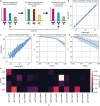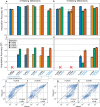A multivalent binding model infers antibody Fc species from systems serology
- PMID: 39715286
- PMCID: PMC11706497
- DOI: 10.1371/journal.pcbi.1012663
A multivalent binding model infers antibody Fc species from systems serology
Abstract
Systems serology aims to broadly profile the antigen binding, Fc biophysical features, immune receptor engagement, and effector functions of antibodies. This experimental approach excels at identifying antibody functional features that are relevant to a particular disease. However, a crucial limitation of this approach is its incomplete description of what structural features of the antibodies are responsible for the observed immune receptor engagement and effector functions. Knowing these antibody features is important for both understanding how effector responses are naturally controlled through antibody Fc structure and designing antibody therapies with specific effector profiles. Here, we address this limitation by modeling the molecular interactions occurring in these assays and using this model to infer quantities of specific antibody Fc species among the antibodies being profiled. We used several validation strategies to show that the model accurately infers antibody properties and then applied the model to infer previously unavailable antibody fucosylation information from existing systems serology data. Using this capability, we find that COVID-19 vaccine efficacy is associated with the induction of afucosylated spike protein-targeting IgG. Our results also question an existing assumption that controllers of HIV exhibit gp120-targeting IgG that are less fucosylated than those of progressors. Additionally, we confirm that afucosylated IgG is associated with membrane-associated antigens for COVID-19 and HIV, and present new evidence indicating that this relationship is specific to the host cell membrane. Finally, we use the model to identify redundant assay measurements and subsets of information-rich measurements from which Fc properties can be inferred. In total, our modeling approach provides a quantitative framework for the reasoning typically applied in these studies, improving the ability to draw mechanistic conclusions from these data.
Copyright: © 2024 Abraham et al. This is an open access article distributed under the terms of the Creative Commons Attribution License, which permits unrestricted use, distribution, and reproduction in any medium, provided the original author and source are credited.
Conflict of interest statement
The authors have declared that no competing interests exist.
Figures







Similar articles
-
Afucosylated IgG characterizes enveloped viral responses and correlates with COVID-19 severity.Science. 2021 Feb 26;371(6532):eabc8378. doi: 10.1126/science.abc8378. Epub 2020 Dec 23. Science. 2021. PMID: 33361116 Free PMC article.
-
Unique carbohydrate-carbohydrate interactions are required for high affinity binding between FcgammaRIII and antibodies lacking core fucose.Proc Natl Acad Sci U S A. 2011 Aug 2;108(31):12669-74. doi: 10.1073/pnas.1108455108. Epub 2011 Jul 18. Proc Natl Acad Sci U S A. 2011. PMID: 21768335 Free PMC article.
-
COVID-19 Severity Is Associated with Differential Antibody Fc-Mediated Innate Immune Functions.mBio. 2021 Apr 20;12(2):e00281-21. doi: 10.1128/mBio.00281-21. mBio. 2021. PMID: 33879594 Free PMC article.
-
More antibodies are not always better: Fc effector functions play a critical role in SARS-CoV-2 infection and protection.Prog Mol Biol Transl Sci. 2025;213:413-447. doi: 10.1016/bs.pmbts.2025.02.001. Epub 2025 Mar 1. Prog Mol Biol Transl Sci. 2025. PMID: 40246351 Review.
-
The "less-is-more" in therapeutic antibodies: Afucosylated anti-cancer antibodies with enhanced antibody-dependent cellular cytotoxicity.MAbs. 2018 Jul;10(5):693-711. doi: 10.1080/19420862.2018.1466767. MAbs. 2018. PMID: 29733746 Free PMC article. Review.

